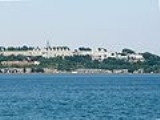
Topkapi Palace
Encyclopedia

is a large palace in Istanbul
Istanbul
Istanbul , historically known as Byzantium and Constantinople , is the largest city of Turkey. Istanbul metropolitan province had 13.26 million people living in it as of December, 2010, which is 18% of Turkey's population and the 3rd largest metropolitan area in Europe after London and...
, Turkey
Turkey
Turkey , known officially as the Republic of Turkey , is a Eurasian country located in Western Asia and in East Thrace in Southeastern Europe...
, that was the primary residence of the Ottoman Sultans for approximately 400 years (1465-1856) of their 624-year reign.
As well as a royal residence, the palace was a setting for state occasions and royal entertainments. It is now a major tourist attraction and contains important holy relics of the Muslim world including the Prophet Muhammed's cloak and sword. The Topkapı Palace is among the monuments contained within the "Historic Areas of Istanbul
Historic Areas of Istanbul
The Historic Areas of Istanbul were added to the UNESCO World Heritage List in 1985.It includes locations such as the Galata Bridge, the Seraglio Point where the Topkapı Palace, the Hagia Sophia, the Sultan Ahmed Mosque, the Yeni Mosque near the Galata Bridge, the Beyazıt Tower and the Süleymaniye...
", which became a UNESCO
UNESCO
The United Nations Educational, Scientific and Cultural Organization is a specialized agency of the United Nations...
World Heritage Site
World Heritage Site
A UNESCO World Heritage Site is a place that is listed by the UNESCO as of special cultural or physical significance...
in 1985, and is described in Criterion iv as "the best example[s] of ensembles of palaces [...] of the Ottoman period."
Construction began in 1459, ordered by Sultan Mehmed II
Mehmed II
Mehmed II , was Sultan of the Ottoman Empire for a short time from 1444 to September 1446, and later from...
, the conqueror of Byzantine Constantinople
Constantinople
Constantinople was the capital of the Roman, Eastern Roman, Byzantine, Latin, and Ottoman Empires. Throughout most of the Middle Ages, Constantinople was Europe's largest and wealthiest city.-Names:...
. The palace complex consists of four main courtyards and many smaller buildings. At its peak, the palace was home to as many as 4,000 people, and covered a large area with a long shoreline. The complex was expanded over the centuries, with major renovations after the 1509 earthquake and the 1665 fire. The palace contained mosques, a hospital, bakeries, and a mint. The name translates as "Cannon gate Palace" from a nearby gate which has since been destroyed.
From the end of the 17th century the Topkapı Palace gradually lost its importance as the Sultans preferred to spend more time in their new palaces along the Bosporus
Bosporus
The Bosphorus or Bosporus , also known as the Istanbul Strait , is a strait that forms part of the boundary between Europe and Asia. It is one of the Turkish Straits, along with the Dardanelles...
. In 1856, Sultan Abdül Mecid I decided to move the court to the newly built Dolmabahçe Palace
Dolmabahçe Palace
Dolmabahçe Palace located in the Beşiktaş district of Istanbul, Turkey, on the European coastline of the Bosphorus strait, served as the main administrative center of the Ottoman Empire from 1856 to 1922, apart from a 22-year interval in which Yıldız Palace was used.- History :Dolmabahçe Palace...
, the first European-style palace in the city. Some functions, such as the imperial treasury, the library, and the mint were retained in the Topkapı Palace.
Following the end of the Ottoman Empire in 1921, the Topkapı Palace was transformed by a government decree dated April 3, 1924 into a museum of the imperial era. The Topkapı Palace Museum is administered by the Ministry of Culture and Tourism. The palace complex has hundreds of rooms and chambers, but only the most important are accessible to the public today. The complex is guarded by officials of the ministry as well as armed guards of the Turkish military. The palace includes many fine examples of Ottoman architecture. It contains large collections of porcelain
Porcelain
Porcelain is a ceramic material made by heating raw materials, generally including clay in the form of kaolin, in a kiln to temperatures between and...
, robes, weapons, shields, armor, Ottoman miniature
Ottoman miniature
Ottoman Miniature or Turkish miniature was an art form in the Ottoman Empire, which can be linked to the Persian miniature tradition, as well as strong Chinese artistic influences. It was a part of the Ottoman Book Arts together with illumination , calligraphy , marbling paper and bookbinding...
s, Islamic calligraphic manuscripts
Islamic calligraphy
Islamic calligraphy, colloquially known as Perso-Arabic calligraphy, is the artistic practice of handwriting, or calligraphy, and by extension, of bookmaking, in the lands sharing a common Islamic cultural heritage. This art form is based on the Arabic script, which for a long time was used by all...
and murals, as well as a display of Ottoman treasures and jewelry.
Site
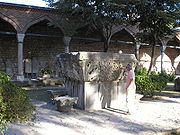
Promontory
Promontory may refer to:*Promontory, a prominent mass of land which overlooks lower lying land or a body of water*Promontory, Utah, the location where the United States first Transcontinental Railroad was completed...
overlooking the Golden Horn
Golden Horn
The Golden Horn is a historic inlet of the Bosphorus dividing the city of Istanbul and forming the natural harbor that has sheltered Greek, Roman, Byzantine, Ottoman and other ships for thousands of...
and the Sea of Marmara
Sea of Marmara
The Sea of Marmara , also known as the Sea of Marmora or the Marmara Sea, and in the context of classical antiquity as the Propontis , is the inland sea that connects the Black Sea to the Aegean Sea, thus separating Turkey's Asian and European parts. The Bosphorus strait connects it to the Black...
, with the Bosphorus in plain sight from many points of the palace. The site is hilly and one of the highest points close to the sea. During Greek and Byzantine times, the acropolis
Acropolis
Acropolis means "high city" in Greek, literally city on the extremity and is usually translated into English as Citadel . For purposes of defense, early people naturally chose elevated ground to build a new settlement, frequently a hill with precipitous sides...
of the ancient Greek city of Byzantion stood here. There is an underground Byzantine cistern
Cistern
A cistern is a waterproof receptacle for holding liquids, usually water. Cisterns are often built to catch and store rainwater. Cisterns are distinguished from wells by their waterproof linings...
, located in the Second Courtyard, which was used throughout Ottoman times, as well as remains of a small church, the so-called Palace Basilica
Palace Basilica
The Palace Basilica is a ruined basilica that was brought to light in the 1937 excavations at the Second Courtyard of Topkapı Palace in Istanbul, Turkey. Since the name of the church cannot be found, the remains have been named after the location of Topkapı Palace...
on the acropolis have also been excavated in modern times. The nearby Church of Hagia Eirene, though located in the First Courtyard, is not considered a part of the old Byzantine acropolis.
Initial construction
After the Ottoman conquest in 1453, Sultan Mehmed II found the imperial Byzantine Great Palace of ConstantinopleGreat Palace of Constantinople
The Great Palace of Constantinople — also known as the Sacred Palace — was the large Imperial Byzantine palace complex located in the south-eastern end of the peninsula now known as "Old Istanbul", modern Turkey...
largely in ruins. The Ottoman court initially set itself up in the Old Palace (Eski Sarayı), today the site of Istanbul University
Istanbul University
Istanbul University is a Turkish university located in Istanbul. The main campus is adjacent to Beyazıt Square.- Synopsis :A madrasa, a religious school, was established sometime in the 15th century after the Ottoman conquest of Constantinople. An institution of higher education named the...
. The Sultan then searched for a better location and chose the old Byzantine acropolis, ordering the construction of a new palace in 1459. It was originally called the New Palace (Yeni Sarayı) to distinguish it from the previous residence. It received the name "Topkapı" (Cannon Gate) in the 19th century, after a (now lost) Topkapı Gate and shore pavilion.
Layout
.jpg)
.jpg)
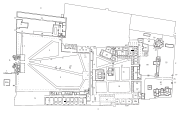
Accounts differ as to when construction of the inner core of the palace started and was finished. Kritovolous gives the dates 1459-1465; other sources suggest a finishing date in the late 1460s.
Unlike other royal residences that had strict master plans, such as Schönbrunn Palace
Schönbrunn Palace
Schönbrunn Palace is a former imperial 1,441-room Rococo summer residence in Vienna, Austria. One of the most important cultural monuments in the country, since the 1960s it has been one of the major tourist attractions in Vienna...
or the Palace of Versailles
Palace of Versailles
The Palace of Versailles , or simply Versailles, is a royal château in Versailles in the Île-de-France region of France. In French it is the Château de Versailles....
, Topkapı Palace developed over the course of centuries, with sultans adding and changing various structures and elements. The resulting asymmetry is the result of this erratic growth and change over time, although the main layout by Mehmed II was preserved. Most of the changes occurred during the reign of Sultan Suleyman from 1520-1560. With the rapid expansion of the Ottoman Empire, Suleyman wanted its growing power and glory to be reflected in his residence, and new buildings were constructed or enlarged. The chief architect in this period was the Persian Alaüddin, also known as Acem Ali. He was also responsible for the expansion of the Harem.
In 1574, a great fire destroyed the kitchens. Sinan was entrusted by Sultan Selim II to rebuild the destroyed parts, which he did, expanding them, as well as the Harem, baths, the Privy Chamber and various shoreline pavilions. By the end of the 16th century, the palace had acquired its present appearance.
The palace is an extensive complex rather than a single monolithic structure, with an assortment of low buildings constructed around courtyards, interconnected with galleries and passages. Few of the buildings exceed two storeys. Interspersed are trees, gardens and water fountains, to give a refreshing feeling to the inhabitants and to provide places to rest.
The buildings enclosed the courtyards, and life revolved around them. Doors and windows face the courtyard to create an open atmosphere and provide cool air during hot summers.
The palace compound, seen from above, is a rough rectangle, divided into four main courtyards and the harem. The main axis is from south to north, the outermost (first) courtyard starting at the south, with each successive courtyard leading north. The first courtyard was the most accessible one, while the innermost (fourth) courtyard and the harem were the most inaccessible, being the sole private domain of the sultan. The fifth courtyard was in reality the outermost rim of the palace grounds bordering the sea. Access to these courtyards was restricted by high walls and controlled with gates. Apart from the four to five main courtyards, various other small to mid-sized courtyards exist throughout the complex. The total size of the complex varies from around 592,600 square meters to 700,000 square meters, depending on which parts are counted.
The southern and western sides border the large former imperial flower park, today Gülhane Park
Gülhane Park
Gülhane Park is a historical urban park in the Eminönü district of Istanbul, Turkey, located adjacent to and on the grounds of the Topkapı Palace; the south entrance of the park sports one of the larger gates of the palace...
. Surrounding the palace compound on the southern and eastern side is the Sea of Marmara. Various related buildings such as small summer palaces (kasrı), pavilions, kiosks (köşkü) and other structures for royal pleasures and functions formerly existed at the shore in an area known as the Fifth Place, but have disappeared over time due to neglect and the construction of the shoreline railroad in the 19th century. The last remaining seashore structure that still exists today is the Basketmakers' Kiosk
Basketmakers' Kiosk
The Basketmakers' Kiosk , also known as Sepetçiler Palace , is a former Ottoman pleasure palace located on the southern shore of Golden Horn's mouth at Sarayburnu in the neighborhood of Sirkeci in Istanbul, Turkey.- History :...
, constructed in 1592 by Sultan Murad III
Murad III
Murad III was the Sultan of the Ottoman Empire from 1574 until his death.-Biography:...
. The total area of Topkapı Palace was in fact much larger than what it is today.
Function
Topkapı Palace was the main residence of the sultan and his court. It was initially the seat of government as well as the imperial residence. Even though access was strictly regulated, inhabitants of the palace rarely had to venture out since the palace functioned almost as an autonomous entity, a city within a city. Audience and consultation chambers and areas served for the political workings of the empire. For the residents and visitors, the palace had its own water supply through underground cisterns and the great kitchens provided for nourishment on a daily basis. Dormitories, gardens, libraries, schools, even mosques, were at the service of the court. Attached to the palace were diverse imperial societies of artists and craftsmen collectively called the Ehl-i Hiref (Community of the Talented), which produced some of the finest work in the whole empire.A strict, ceremonial, codified daily life ensured imperial seclusion from the rest of world. One of the central tenets was the observation of silence in the inner courtyards. The principle of imperial seclusion is a tradition that was probably continued from the Byzantine court. It was codified by Mehmed II in 1477 and 1481 in the Kanunname Code, which regulated the rank order of court officials, the administrative hierarchy, and protocol matters.
This principle of increased seclusion over time was reflected in the construction style and arrangements of various halls and buildings. The architects had to ensure that even within the palace, the sultan and his family could enjoy a maximum of privacy and discretion, making use of grilled windows and building secret passageways.
Imperial Gate
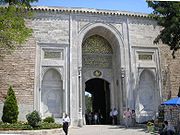
Mese (Constantinople)
The Mese was the main thoroughfare of ancient Constantinople . The street was the main scene of Byzantine imperial processions. Its ancient course is largely followed by the modern Divanyolu Avenue.- Description :...
avenue, today Divan Yolu (Street of the Council). The Mese was used for imperial processions during the Byzantine and Ottoman era. It leads directly to the Hagia Sophia
Hagia Sophia
Hagia Sophia is a former Orthodox patriarchal basilica, later a mosque, and now a museum in Istanbul, Turkey...
and takes a turn northwest towards the palace square where the landmark Fountain of Ahmed III
Fountain of Ahmed III
The Fountain of Sultan Ahmed III is a fountain in a Turkish rococo structure located in the great square in front of the Imperial Gate of Topkapı Palace in Istanbul, Turkey. It was built under Ottoman sultan Ahmed III in 1728, in the style of the Tulip period...
stands. The sultan would enter the palace through the Imperial Gate ( or Latin: Porta Augusta), also known as "Gate of the Sultan" (Turkish: Saltanat Kapısı) located to the south of the palace. This massive gate, originally dating from 1478, is now covered in 19th-century marble. The massiveness of this stone gate accentuates its defensive character. Its central arch leads to a high-domed passage. Gilded Ottoman calligraphy
Calligraphy
Calligraphy is a type of visual art. It is often called the art of fancy lettering . A contemporary definition of calligraphic practice is "the art of giving form to signs in an expressive, harmonious and skillful manner"...
adorns the structure at the top, with verses from the Qur'an
Qur'an
The Quran , also transliterated Qur'an, Koran, Alcoran, Qur’ān, Coran, Kuran, and al-Qur’ān, is the central religious text of Islam, which Muslims consider the verbatim word of God . It is regarded widely as the finest piece of literature in the Arabic language...
and tughra
Tughra
A tughra is a calligraphic monogram, seal or signature of an Ottoman sultan that was affixed to all official documents and correspondence. It was also carved on his seal and stamped on the coins minted during his reign...
s of the sultans. Identified tughras are of Sultan Mehmed II
Mehmed II
Mehmed II , was Sultan of the Ottoman Empire for a short time from 1444 to September 1446, and later from...
and Abdül Aziz I, who renovated the gate.
One of the inscriptions at the gate proclaims:
On each side of the hall are rooms for the guard. The gate was open from morning prayer until the last evening prayer.
According to old documents, there was a wooden apartment above the gate area until the second half of the 19th century. It was used first as a pavilion by Mehmed, later as a depository for the properties of those who died inside the palace without heirs and eventually as the receiving department of the treasury. It was also used as a vantage point for the ladies of the harem on special occasions.
The Imperial Gate is the main entrance into the First Courtyard. The four courtyards lead to each other and during the Ottoman Empire, each became steadily more exclusive leading to the Fourth Courtyard, which was the sultan's private courtyard.
First Courtyard

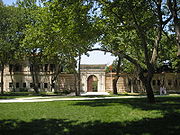
This First Courtyard functioned as an outer precinct or park and is the largest of all the courtyards of the palace. The steep slopes leading towards the sea had already been terraced under Byzantine rule.
The First Courtyard contained purely functional structures and some royal ones, many of which don't exist today. The structures that remain are the former Imperial Mint
Mint (coin)
A mint is an industrial facility which manufactures coins for currency.The history of mints correlates closely with the history of coins. One difference is that the history of the mint is usually closely tied to the political situation of an era...
(Darphane-i Âmire, constructed in 1727), the church of Hagia Irene and various fountains. The Byzantine church of Hagia Irene
Hagia Irene
Hagia Irene or Hagia Eirene , often erroneously rendered in English as St Irene, is a former Eastern Orthodox church located in the outer courtyard of Topkapı Palace in Istanbul, Turkey. It is open as a museum every day except Monday but requires special permission for admission.-Church:The...
was never destroyed by the conquering Ottomans and survived by being used as a storehouse and imperial armoury.
This court was also known as the Court of the Janissaries or the Parade Court. Visitors entering the palace would follow the path towards the Gate of Salutation and the Second Courtyard of the palace. Court officials and janissaries would line the path dressed in their best garbs and waiting. Visitors had to dismount from the horses between the First and the Second Courtyard.
Gate of Salutation

Mehmed II
Mehmed II , was Sultan of the Ottoman Empire for a short time from 1444 to September 1446, and later from...
. In a miniature painting from the Hünername from 1584, a low-roofed structure with three windows above the arch between the towers is clearly visible, probably a guards' hall that has since disappeared. The gate is richly decorated on both sides and in the upper part with religious inscriptions and monograms of sultans.
No one apart for official purpose and foreign dignitaries were allowed passage through the gate. All visitors had to dismount by the Middle Gate, since only the sultan was allowed to enter the gate on horseback. This was also a Byzantine tradition taken from the Chalke
Chalke
The Chalke Gate , was the main ceremonial entrance to the Great Palace of Constantinople in the Byzantine period. The name, which means "the Bronze Gate", was given to it either because of the bronze portals or from the gilded bronze tiles used in its roof. The interior was lavishly decorated with...
Gate of the Great Palace
Great Palace of Constantinople
The Great Palace of Constantinople — also known as the Sacred Palace — was the large Imperial Byzantine palace complex located in the south-eastern end of the peninsula now known as "Old Istanbul", modern Turkey...
.
The Fountain of the Executioner (Cellat Çeşmesi) is where the executioner purportedly washed his hands and sword after a decapitation
Decapitation
Decapitation is the separation of the head from the body. Beheading typically refers to the act of intentional decapitation, e.g., as a means of murder or execution; it may be accomplished, for example, with an axe, sword, knife, wire, or by other more sophisticated means such as a guillotine...
, although there is disagreement if this is indeed that particular fountain. It is located on the right side when facing the Gate of Salutation from the First Courtyard.
Second Courtyard

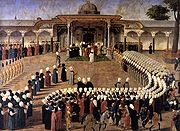
Gazelle
A gazelle is any of many antelope species in the genus Gazella, or formerly considered to belong to it. Six species are included in two genera, Eudorcas and Nanger, which were formerly considered subgenera...
s, used as a gathering place for courtiers. This courtyard is considered the outer one (Birûn). Only the Sultan was allowed to ride on the black pebbled walks that lead to the Third Courtyard.
The courtyard was completed probably around 1465 during the reign of Mehmed II, but received its final appearance around 1525-1529 during the reign of Suleyman I. This courtyard is surrounded by the former palace hospital, bakery, Janissary
Janissary
The Janissaries were infantry units that formed the Ottoman sultan's household troops and bodyguards...
quarters, stables, the imperial harem and Divan
Divan
A divan was a high governmental body in a number of Islamic states, or its chief official .-Etymology:...
to the north and the kitchens to the south. At the end of the courtyard, the Gate of Felicity marks the entrance to the Third Courtyard. The whole area is unified by a continuous marble colonnade, creating an ensemble.
Numerous artifacts from the Roman and Byzantine periods have been found on the palace site during recent excavations. These include sarcophagi
Sarcophagus
A sarcophagus is a funeral receptacle for a corpse, most commonly carved or cut from stone. The word "sarcophagus" comes from the Greek σαρξ sarx meaning "flesh", and φαγειν phagein meaning "to eat", hence sarkophagus means "flesh-eating"; from the phrase lithos sarkophagos...
, baptismal fonts, parapet
Parapet
A parapet is a wall-like barrier at the edge of a roof, terrace, balcony or other structure. Where extending above a roof, it may simply be the portion of an exterior wall that continues above the line of the roof surface, or may be a continuation of a vertical feature beneath the roof such as a...
slabs and pillars and capitals. They are on display in the Second Courtyard in front of the imperial kitchens. Located underneath the Second Courtyard is a cistern
Cistern
A cistern is a waterproof receptacle for holding liquids, usually water. Cisterns are often built to catch and store rainwater. Cisterns are distinguished from wells by their waterproof linings...
that dates to Byzantine times. It is normally closed to the public.
The Second Courtyard was primarily used by the sultan to dispense justice and hold audiences. This was done here also to impress visitors. Various Austrian, Venetian
Adriatic Veneti
The Veneti were an ancient people who inhabited north-eastern Italy, in an area corresponding to the modern-day region of the Veneto....
and French
French people
The French are a nation that share a common French culture and speak the French language as a mother tongue. Historically, the French population are descended from peoples of Celtic, Latin and Germanic origin, and are today a mixture of several ethnic groups...
ambassadors have left accounts of what such an audience looked like. The French ambassador Philippe du Fresne-Canaye led an embassy in 1573 to the sultan:
A strict protocol that governed the functioning and workings of the Second Courtyard was to ensure discipline and respect, as well as lend an air of majesty to the court.
Imperial carriages
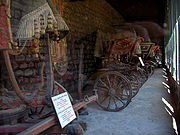
Palace kitchens

Edirne
Edirne is a city in Eastern Thrace, the northwestern part of Turkey, close to the borders with Greece and Bulgaria. Edirne served as the capital city of the Ottoman Empire from 1365 to 1453, before Constantinople became the empire's new capital. At present, Edirne is the capital of the Edirne...
. They were enlarged during the reign of Sultan Süleyman the Magnificent but burned down in 1574. The kitchens were remodeled and brought up to date according to the needs of the day by the court architect Mimar Sinan.
Rebuilt to the old plan by Sinan, they form two rows of 20 wide chimneys (added by Sinan), rising like stacks from a ship from domes on octagonal drums.
The kitchens are arranged on an internal street stretching between the Second Courtyard and the Sea of Marmara. The entrance to this section is through the three doors in the portico of the Second Courtyard: the Imperial commissariat (lower kitchen) door, imperial kitchen door and the confectionery kitchen door.
The palace kitchens consist of 10 domed buildings: Imperial kitchen, Enderûn (palace school), Harem (women’s quarters), Birûn (outer service section of the palace), kitchens, beverages kitchen, confectionery
Confectionery
Confectionery is the set of food items that are rich in sugar, any one or type of which is called a confection. Modern usage may include substances rich in artificial sweeteners as well...
kitchen, creamery
Creamery
In a dairy, the creamery is the location of cream processing. Cream is separated from whole milk; pasteurization is done to the skimmed milk and cream separately. Whole milk for sale has had some cream returned to the skimmed milk....
, storerooms and rooms for the cooks. They were the largest kitchens in the Ottoman Empire.
The meals for the Sultan, the residents of the Harem, Enderûn and Birûn (the inner and outer services of the palace) were prepared here. Food was prepared for about 4,000 people. The kitchen staff consisted of more than 800 people, rising to 1,000 on religious holidays. As many as 6,000 meals a day could be prepared. Even the serving of food to the sultan was strictly regulated by protocol.
The kitchens included dormitories, baths and a mosque for the employees, most of which disappeared over time.
Apart from exhibiting kitchen utensils, today the buildings contain a silver gifts and utensils collection, as well as large collections of Chinese blue-and-white, white, and celadon
Celadon
Celadon is a term for ceramics denoting both a type of glaze and a ware of a specific color, also called celadon. This type of ware was invented in ancient China, such as in the Zhejiang province...
porcelain.
Porcelain and celadon collection

Camel train
A camel train is a series of camels carrying goods or passengers in a group as part of a regular or semi-regular service between two points. Although they rarely travelled faster than the walking speed of a man, camels' ability to handle harsh conditions made camel trains a vital part of...
s over the Silk Road
Silk Road
The Silk Road or Silk Route refers to a historical network of interlinking trade routes across the Afro-Eurasian landmass that connected East, South, and Western Asia with the Mediterranean and European world, as well as parts of North and East Africa...
or by sea. The 10,700 pieces of Chinese porcelain displayed here are rare, precious, and thought to rival that found in China as one of the finest collections in the world. The Chinese porcelain collection ranges from the late Song Dynasty
Song Dynasty
The Song Dynasty was a ruling dynasty in China between 960 and 1279; it succeeded the Five Dynasties and Ten Kingdoms Period, and was followed by the Yuan Dynasty. It was the first government in world history to issue banknotes or paper money, and the first Chinese government to establish a...
(960-1279) and the Yuan Dynasty
Yuan Dynasty
The Yuan Dynasty , or Great Yuan Empire was a ruling dynasty founded by the Mongol leader Kublai Khan, who ruled most of present-day China, all of modern Mongolia and its surrounding areas, lasting officially from 1271 to 1368. It is considered both as a division of the Mongol Empire and as an...
(1280–1368), through the Ming Dynasty
Ming Dynasty
The Ming Dynasty, also Empire of the Great Ming, was the ruling dynasty of China from 1368 to 1644, following the collapse of the Mongol-led Yuan Dynasty. The Ming, "one of the greatest eras of orderly government and social stability in human history", was the last dynasty in China ruled by ethnic...
(1368–1644) to the Qing Dynasty
Qing Dynasty
The Qing Dynasty was the last dynasty of China, ruling from 1644 to 1912 with a brief, abortive restoration in 1917. It was preceded by the Ming Dynasty and followed by the Republic of China....
(1644–1912). This museum also contains one of the world's largest collections of 14th-century Longquan celadon
Longquan celadon
Longquan celadon refers to Chinese celadon produced in Longguan kilns which were largely located in Lishui prefecture in southwestern Zhejiang Province...
. The collection has around 3,000 pieces of Yuan and Ming Dynasty celadons. Those celadon were valued by the Sultan and the Queen Mother because it was supposed to change colour if the food or drink it carried was poisoned. The Japanese collection is mainly Imari porcelain
Imari porcelain
Imari porcelain is the name for Japanese porcelain wares made in the town of Arita, in the former Hizen Province, northwestern Kyūshū. They were exported to Europe extensively from the port of Imari, Saga between latter half of 17th century and former half of 18 th century, Japanese as well as the...
, dating from the 17th to the 19th century. Further parts of the collection include white porcelain from the beginning of the 15th century and "imitation" Blue-and-White and Imari porcelain from Vietnam
Vietnam
Vietnam – sometimes spelled Viet Nam , officially the Socialist Republic of Vietnam – is the easternmost country on the Indochina Peninsula in Southeast Asia. It is bordered by China to the north, Laos to the northwest, Cambodia to the southwest, and the South China Sea –...
, Thailand
Thailand
Thailand , officially the Kingdom of Thailand , formerly known as Siam , is a country located at the centre of the Indochina peninsula and Southeast Asia. It is bordered to the north by Burma and Laos, to the east by Laos and Cambodia, to the south by the Gulf of Thailand and Malaysia, and to the...
and Persia.
Imperial stables
Located on the other side of the courtyard, around five to six meters below ground level, are the imperial stables (Istabl-ı Âmire). The stables include the privy stables (Has Ahir) and were constructed under Mehmed II and renovated under Suleyman. A vast collection of harnessHorse harness
A horse harness is a type of horse tack that allows a horse or other equine to pull various horse-drawn vehicles such as a carriage, wagon or sleigh. Harnesses may also be used to hitch animals to other loads such as a plow or canal boat....
treasures (Raht Hazinesi) is kept in the privy stables. Also located there is the small 18th century mosque and bath of Beşir Ağa (Beşir Ağa Camii ve Hamamı), the chief black eunuch of Mahmud I.
Dormitories of the Halberdiers with Tresses
At the end of the imperial stables are the Dormitories of the Halberdiers with Tresses (Zülüflü Baltacılar Koğušu). These quarters were used by a corps that was responsible for carrying wood to the palace rooms, cleaning and serving service for the harem and the quarters of the male pages, moving furniture and acting as masters of ceremonies. The halberdHalberd
A halberd is a two-handed pole weapon that came to prominent use during the 14th and 15th centuries. Possibly the word halberd comes from the German words Halm , and Barte - in modern-day German, the weapon is called Hellebarde. The halberd consists of an axe blade topped with a spike mounted on...
iers wore long tresses to signify their higher position. The first mention of this corps is around 1527, when they were established to clear the roads ahead of the army during a campaign.
The dormitory was founded in the 15th century. It was enlarged by the chief architect Davud Ağa in 1587, during the reign of Sultan Murad III. The dormitories are constructed around a main courtyard in the traditional layout of an Ottoman house, with baths and a mosque, as well as recreational rooms such as a pipe-room. On the outside and inside of the complex, many pious foundation inscriptions about the various duties and upkeep of the quarters can be found. In contrast to the rest of the palace, the quarters are constructed by wood, which is painted in red and green.
Imperial Council
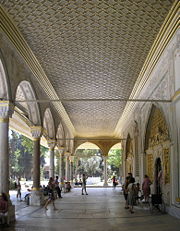
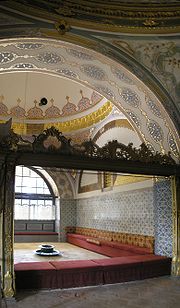
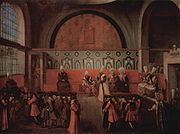
The first Council chambers in the palace were built during the reign of Mehmed II, and the present building dates from the period of Süleyman the Magnificent by the chief architect Alseddin. It has since undergone several changes, was much damaged and restored after the Harem fire of 1665, and according to the entrance inscription it was also restored during the periods of Selim III and Mahmud II.
From the 18th century onwards, the place began to lose its original importance, as state administration was gradually transferred to the Sublime Porte (Bâb-ı Âli) of the Grand Viziers. The last meeting of the Council in the palace chambers was held on Wednesday, August 30, 1876, when the cabinet (Vükela Heyeti) met to discuss the state of Murat V, who had been indisposed for some time.
The council hall has multiple entrances both from inside the palace and from the courtyard. The porch consists of multiple marble and porphyry pillars, with an ornate green and white-coloured wooden ceiling decorated with gold. The floor is covered in marble. The entrances into the hall from outside are in the rococo style, with gilded grills to admit natural light. While the pillars are earlier Ottoman style, the wall paintings and decorations are from the later rococo period. Inside, the Imperial Council building consists of three adjoining main rooms. Two of the three domed chambers of this building open into the porch and the courtyard. The Divanhane, built with a wooden portico at the corner of the Divan Court (Divan Meydani) in the 15th century, was later used as the mosque of the council but was removed in 1916. There are three domed chambers:
- The first chamber where the Imperial CouncilImperial CouncilThe term Imperial Council might refer to any of the following:* State Council of Imperial Russia* Imperial Council of Austria...
held its deliberations is the Kubbealtı. - The second chamber was occupied by the secretarial staff of the Imperial Divan.
- In the adjacent third chamber called Defterhāne, records were kept by the head clerks. The last room also served as a document archive.
On its façade are verse inscriptions, which mention the restoration work carried out in 1792 and 1819, namely under Sultan Selim III
Selim III
Selim III was the reform-minded Sultan of the Ottoman Empire from 1789 to 1807. The Janissaries eventually deposed and imprisoned him, and placed his cousin Mustafa on the throne as Mustafa IV...
and Mahmud II
Mahmud II
Mahmud II was the 30th Sultan of the Ottoman Empire from 1808 until his death in 1839. He was born in the Topkapi Palace, Istanbul, the son of Sultan Abdulhamid I...
. The rococo
Rococo
Rococo , also referred to as "Late Baroque", is an 18th-century style which developed as Baroque artists gave up their symmetry and became increasingly ornate, florid, and playful...
decorations on the façade and inside the Imperial Council date from this period. The main chamber Kubbealtı is, however, decorated with Ottoman Kütahya tiles. Three long sofas along the sides were the seats for the officials, with a small hearth in the middle. The small gilded ball that hangs from the ceiling represents the earth. It is placed in front of the sultan's window and symbolises him dispensing justice to the world, as well as keeping the powers of his viziers in check.
In the Imperial Council meetings, the political, administrative and religious affairs of the state and important concerns of the citizens were discussed. The Imperial Council normally met four times a week (Saturday, Sunday, Monday and Tuesday) after prayer at dawn. The meetings of the Imperial Council were run according to an elaborate and strict protocol.
Council members such as the Grand Vizier, viziers, chief military officials of the Muslim Judiciary (Kazaskers) of Rumelia
Rumelia
Rumelia was an historical region comprising the territories of the Ottoman Empire in Europe...
and Anatolia
Anatolia
Anatolia is a geographic and historical term denoting the westernmost protrusion of Asia, comprising the majority of the Republic of Turkey...
, the Minister of Finance or heads of the Treasury (defterdar), the Minister of Foreign Affairs (Reis-ül-Küttab) and sometimes the Grand Müfti
Mufti
A mufti is a Sunni Islamic scholar who is an interpreter or expounder of Islamic law . In religious administrative terms, a mufti is roughly equivalent to a deacon to a Sunni population...
(Sheikh ül-İslam) met here to discuss and decide the affairs of state.
Other officials who were allowed were the Nişancilar secretaries of the Imperial Council and keepers of the royal monogram (tuğra) and the officials charged with the duty of writing official memoranda (Tezkereciler), and the clerks recording the resolutions.
From the window with the golden grill, the Sultan or the Valide Sultan
Valide Sultan
Valide Sultan was the title held by the mother of a ruling Sultan in the Ottoman Empire. The Turkish pronunciation of the word Valide is . The title is sometimes translated as Queen Mother, although the position of Valide Sultan was quite different.The position was perhaps the most important...
was able to follow deliberations of the council without being noticed. The window could be reached from the imperial quarters in the adjacent Tower of Justice (Adalet Kulesi). When the sultan rapped on the grill or drew the red curtain, the Council session was terminated, and the viziers were summoned one by one to the Audience Hall (Arz Odası) to present their reports to the sultan.
All the statesmen, apart from the Grand Vizier, performed their dawn prayers in the Hagia Sophia
Hagia Sophia
Hagia Sophia is a former Orthodox patriarchal basilica, later a mosque, and now a museum in Istanbul, Turkey...
and entered the Imperial Gate according to their rank, passing through the Gate of Salutation and into the divan chamber, where they would wait for the arrival of the Grand Vizier. The Grand Vizier performed his prayers at home, and was accompanied to the palace by his own attendants. On his arrival there, he was given a ceremonial welcome, and before proceeding to the imperial divan, he would approach the Gate of Felicity and salute it as if paying his respects to the gate of the sultan's house. He entered the chamber and took his seat directly under the sultan's window and council commenced. Affairs of the state were generally discussed until noon, when the members of the Council dined in the chambers and after which petitions were heard here. All the members of Ottoman society, men and women of all creeds, were granted a hearing. An important ceremony was held to mark the first Imperial Council of each new Grand Vizier, and also to mark his presentation with the Imperial Seal (Mühr-ü Hümayûn). The most important ceremony took place every three months during the handing out of salaries (ulûfe) to the Janissaries. The reception of foreign dignitaries was normally arranged for the same day, creating an occasion to reflect the wealth and might of the state. Ambassadors were then received by the Grand Vizier in the Council chambers, where a banquet was held in their honour.
Tower of Justice
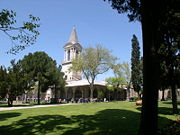
The tower was probably originally constructed under Mehmed II and then renovated and enlargened by Suleiman I between 1527-1529.
Sultan Mahmud II rebuilt the lantern of the tower in 1825 while retaining the Ottoman base. The tall windows with engaged columns and the Renaissance
Renaissance
The Renaissance was a cultural movement that spanned roughly the 14th to the 17th century, beginning in Italy in the Late Middle Ages and later spreading to the rest of Europe. The term is also used more loosely to refer to the historical era, but since the changes of the Renaissance were not...
pediments evoke the Palladian
Palladian architecture
Palladian architecture is a European style of architecture derived from the designs of the Venetian architect Andrea Palladio . The term "Palladian" normally refers to buildings in a style inspired by Palladio's own work; that which is recognised as Palladian architecture today is an evolution of...
style.
The tower symbolises the eternal vigilance of the sultan against injustice. Everyone from afar was supposed to be able to see the tower to feel assured about the sultan's presence. The tower was also used by the sultan for viewing pleasures. The old tower used to have grilled windows, enabling him to see without being seen, adding to the aura of seclusion. The golden window in the Imperial Council is accessible through the Tower of Justice, thus adding to the importance of the symbolism of justice.
Imperial Treasury
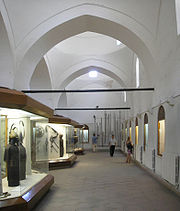
This treasury was used to finance the administration of the state. The kaftans given as presents to the viziers, ambassadors and residents of the palace by the financial department and the sultan and other valuable objects were also stored here. The janissaries were paid their quarterly wages (called uluefe) from this treasury, which was closed by the imperial seal entrusted to the grand vizier. In 1928, four years after the Topkapi Palace was converted into a museum, its collection of arms and armour was put on exhibition in this building.
During excavations in 1937 in front of this building, remains of a religious Byzantine building dating from the 5th century were found. Since it could not be identified with any of the churches known to have been built on the palace site, it is now known as "the Basilica of the Topkapı Palace" or simply Palace Basilica
Palace Basilica
The Palace Basilica is a ruined basilica that was brought to light in the 1937 excavations at the Second Courtyard of Topkapı Palace in Istanbul, Turkey. Since the name of the church cannot be found, the remains have been named after the location of Topkapı Palace...
.
Also located outside the treasury building is a target stone (Nişan Taşı), which is over two metres tall. This stone was erected in commemoration of a record rifle shot by Selim III in 1790. It was brought to the palace from Levend in the 1930s.
Arms collection
The arms collection (Silah Seksiyonu Sergi Salonu), which consists primarily of weapons that remained in the palace at the time of its conversion, is one of the richest assemblages of Islamic arms in the world, with examples spanning a period of 1,300 years from the seventh to the 20th century. The palace's collection of arms and armour consists of objects manufactured by the Ottomans themselves, or gathered from foreign conquests, or given as presents. Ottoman weaponsOttoman weapons
The Military of the Ottoman Empire used a variety of weapons in their conquests throughout the centuries. The armoury in Topkapı Palace has a large collection of which it shows select items.- Armour :...
form the bulk of the collection, but it also includes examples of Umayyad
Umayyad
The Umayyad Caliphate was the second of the four major Arab caliphates established after the death of Muhammad. It was ruled by the Umayyad dynasty, whose name derives from Umayya ibn Abd Shams, the great-grandfather of the first Umayyad caliph. Although the Umayyad family originally came from the...
and Abbasid
Abbasid
The Abbasid Caliphate or, more simply, the Abbasids , was the third of the Islamic caliphates. It was ruled by the Abbasid dynasty of caliphs, who built their capital in Baghdad after overthrowing the Umayyad caliphate from all but the al-Andalus region....
swords, as well as Mamluk
Mamluk
A Mamluk was a soldier of slave origin, who were predominantly Cumans/Kipchaks The "mamluk phenomenon", as David Ayalon dubbed the creation of the specific warrior...
and Persian armour, helmets, swords and axes. A lesser number of European and Asian arms make up the remainder of the collection. Currently on exhibition are some 400 weapons, most of which bear inscriptions.
Gate of Felicity
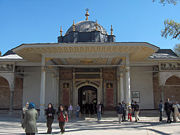
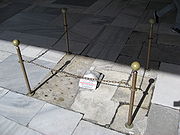
The gate was probably constructed under Mehmed II in the 15th century. It was redecorated in the rococo style in 1774 under Sultan Mustafa III
Mustafa III
Mustafa III was the Sultan of the Ottoman Empire from 1757 to 1774. He was a son of Sultan Ahmed III and was succeeded by his brother Abdul Hamid I . He was born in Edirne...
and during the reign of Mahmud II. The gate is further decorated with Qur'anic verses above the entrance and tuğras. The ceiling is partly painted and gold-leafed, with a golden ball hanging from the middle. The sides with baroque decorative elements and miniature paintings of landscapes.
The Sultan used this gate and the Divan Meydanı square only for special ceremonies. The Sultan sat before the gate on his Bayram throne on religious, festive days and accession, when the subjects and officials perform their homage standing. The funerals of the Sultan were also conducted in front of the gate.
On either side of this colonnaded passage, under control of the Chief Eunuch of the Sultan’s Harem (called the Bâbüssaâde Ağası) and the staff under him, were the quarters of the eunuchs as well as the small and large rooms of the palace school.
The small, indented stone on the ground in front of the gate marks the place where the banner of the Prophet Muhammad
Muhammad
Muhammad |ligature]] at U+FDF4 ;Arabic pronunciation varies regionally; the first vowel ranges from ~~; the second and the last vowel: ~~~. There are dialects which have no stress. In Egypt, it is pronounced not in religious contexts...
was unfurled. The Grand Vizier or the commander going to war was entrusted with this banner in a solemn ceremony.
Third Courtyard

The Sacred Trusts
The Islamic Sacred Relics , also known as the Holy Relics, consist of religious pieces sent to the Ottoman Sultans between the 16th century to the late 19th century....
), the Harem and some pavilions, with the library of Ahmed III
Ahmed III
Ahmed III was Sultan of the Ottoman Empire and a son of Sultan Mehmed IV . His mother was Mâh-Pâre Ummatullah Râbi'a Gül-Nûş Valide Sultan, originally named Evmania Voria, who was an ethnic Greek. He was born at Hajioglupazari, in Dobruja...
in the center. Entry to the Third Courtyard was strictly regulated and off-limits to outsiders.
The Third Courtyard is surrounded by the quarters of the Ağas (pages), boys in the service of the sultan. They were taught the arts, such as music, painting and calligraphy
Calligraphy
Calligraphy is a type of visual art. It is often called the art of fancy lettering . A contemporary definition of calligraphic practice is "the art of giving form to signs in an expressive, harmonious and skillful manner"...
. The best could become Has Odali Ağa (Keepers of the Holy Relics of the Prophet and personal servants of the Sultan), or even become officers or high-ranking officials.
The layout of the Third Courtyard was established by Mehmed II. Its size is roughly comparable to the Second Courtyard. The rigid layout did not allow for any great changes. While Mehmed II would not sleep in the harem, successive sultans after him became more secluded and moved to the more intimate Fourth Courtyard and the harem section.
The Hünername miniature from 1584 shows the Third Courtyard and the surrounding outer gardens as it must have appeared following its completion under Mehmed II. It also shows at the bottom the sultan in what looks like a shore pavilion either holding audience or being entertained by courtiers.
Audience Chamber
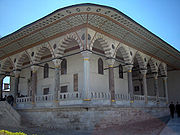
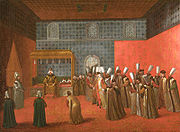
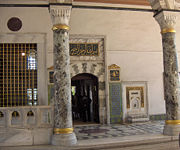
It is an old building, dating from the 15th century, and further decorated under Suleiman I. Here the sultan would sit on the canopied throne and personally receive the viziers, officials and foreign ambassadors who presented themselves. According to a contemporary account by envoy Cornelius Duplicius de Schepper in 1533:
The viziers came here to present their individual reports to the sultan. Depending on their performance and reports, the sultan showed his pleasure by showering them with gifts and high offices, or in the worst case having them strangled
Strangling
Strangling is compression of the neck that may lead to unconsciousness or death by causing an increasingly hypoxic state in the brain. Fatal strangling typically occurs in cases of violence, accidents, and as the auxiliary lethal mechanism in hangings in the event the neck does not break...
by deaf-mute eunuchs. The chamber was thus a place that officials reporting to the sultan entered without knowing if they would leave it again alive.
The most elaborate ceremonies were conducted during the reception of ambassadors who came, escorted by officials, to kiss the hem of the sultan's skirt. The throne was richly decorated during the ceremonies.
The present throne in the form of a baldachin was made by order of Mehmed III. On the lacquered ceiling of the throne, studded with jewels, are foliage patterns accompanied by the depiction of the fight of a dragon, symbol of power, with simurg, a mythical bird. On the throne there is a cover made of several pieces of brocade on which emerald and ruby plaques and pearls are sown.
The ceiling of the chamber was painted in ultramarine blue and studded with golden stars. The tiles that lined the walls were also blue, white and turquoise. The chamber was further decorated with precious carpets and pillows. This was to impress the visitors and hold them in awe of the power and presence of the sultan. The chamber was renovated in 1723 by Sultan Ahmed III and rebuilt in its present form after it was destroyed by fire in 1856 during the rule of Abülmecid I. Today's interior therefore is very different from how it appeared after completion.
Two doors in front lead out into a porch, another one to the back. The two doors in front were for visitors while the third one was for the sultan himself. The embossed inscriptions at the main visitors' door, having the form of the sultan's monogram and containing laudatory words for Sultan Abdülmecid I, date from 1856. The main door is surmounted by an embossed besmele (the Muslim confession of faith "In the Name of God the Compassionate, the Merciful") dating from 1723. The inscription was added during the reign of Sultan Ahmed III. The tile panels on either side of the door were placed during later repair work.
There is a small fountain at the entrance by Suleiman I. The fountain was used not only for refreshment, but could be used to prevent others from overhearing secret conversations in this room. The fountain was also a symbol of the sultan; the Persian inscriptions calls him "the fountainhead of generosity, justice and the sea of beneficence."
Gifts presented by ambassadors were placed in front of the large window in the middle of the main facade between the two doors. The Pişkeş Gate to the left (Pişkeş Kapısı, Pişkeş meaning gift brought to a superior) is surmounted by an inscription from the reign of Mahmud II, which dates from 1810.
Behind the Audience Chamber on the eastern side is the Dormitory of the Expeditionary Force.
Dormitory of the Expeditionary Force
The Dormitory of the Expeditionary Force (Seferli Koğuşu) houses the Imperial Wardrobe Collection (Padişhah Elbiseleri Koleksiyonu) with a valuable costume collection of about 2,500 garments, the majority precious kaftans of the Sultans. It also houses a collection of 360 ceramic objects.The dormitory was constructed under Sultan Murad IV
Murad IV
Murad IV Ghazi was the Sultan of the Ottoman Empire from 1623 to 1640, known both for restoring the authority of the state and for the brutality of his methods...
in 1635. The building was restored by Sultan Ahmed III in the early 18th century. The dormitory is vaulted and is supported by 14 columns. Adjacent to the dormitory, located northeast, is the Conqueror's Pavilion.
Conqueror’s Pavilion
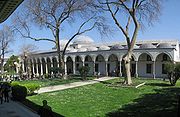

The pavilion originally consisted of three rooms, a terrace overlooking the Sea of Marmara, a basement and adjoining hamam, or Turkish bath.
It consists of two floors raised on a terrace above the garden, built at the top of the promontory on a cliff with a magnificent view from its porch on the Sea of Marmara and the Bosporus. The lower floor consisted of service rooms, while the upper floor was a suite of four apartments and a large loggia with double arches. The first two rooms are covered with a dome of considerable height. All the rooms open onto the Third Courtyard through a monumental arcade
Arcade (architecture)
An arcade is a succession of arches, each counterthrusting the next, supported by columns or piers or a covered walk enclosed by a line of such arches on one or both sides. In warmer or wet climates, exterior arcades provide shelter for pedestrians....
. The colonnaded portico on the side of the garden is connected to each of the four halls by a door of imposing height. The capitals of the imposing capitals are shrunken Ionic in form and date probably from the 18th century. The pavilion was used as the treasury for the revenues from Egypt
Egypt
Egypt , officially the Arab Republic of Egypt, Arabic: , is a country mainly in North Africa, with the Sinai Peninsula forming a land bridge in Southwest Asia. Egypt is thus a transcontinental country, and a major power in Africa, the Mediterranean Basin, the Middle East and the Muslim world...
under Sultan Selim I
Selim I
Selim I, Yavuz Sultân Selim Khan, Hâdim-ül Haramain-ish Sharifain , nicknamed Yavuz "the Stern" or "the Steadfast", but often rendered in English as "the Grim" , was the Sultan of the Ottoman Empire from 1512 to...
. Before this period, under Mehmed II and Bayezid II
Bayezid II
Bayezid II or Sultân Bayezid-î Velî was the oldest son and successor of Mehmed II, ruling as Sultan of the Ottoman Empire from 1481 to 1512...
, these apartments must have been the most agreeable rooms in the palace. During excavations in the basement, a small Byzantine baptistery
Baptistery
In Christian architecture the baptistry or baptistery is the separate centrally-planned structure surrounding the baptismal font. The baptistry may be incorporated within the body of a church or cathedral and be provided with an altar as a chapel...
built along a trefoil plan was found.
Imperial Treasury
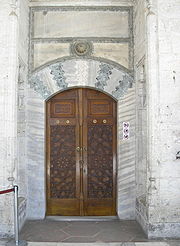
Most of the objects in the Imperial Treasury consisted of gifts, spoils of war, or pieces produced by palace craftsmen. The Chief Treasurer (Hazinedarbaşı) was responsible for the Imperial Treasury. Upon their accession to the throne, it was customary for the sultans to pay a ceremonial visit to the Treasury.
The objects exhibited in the Imperial Treasury today are a representative selection of its contents, which mainly consist of jeweled objects made of gold and other precious materials.
Among the many treasuries that are on exhibition in four adjoining rooms, the first room houses one the armours of Sultan Mustafa III
Mustafa III
Mustafa III was the Sultan of the Ottoman Empire from 1757 to 1774. He was a son of Sultan Ahmed III and was succeeded by his brother Abdul Hamid I . He was born in Edirne...
, consisting of an iron coat of mail decorated with gold and encrusted with jewels, his gilded sword and shield and gilded stirrups. The next display shows several Qur'an covers belonging to the sultans, decorated with pearls. The ebony throne of Murad IV
Murad IV
Murad IV Ghazi was the Sultan of the Ottoman Empire from 1623 to 1640, known both for restoring the authority of the state and for the brutality of his methods...
is inlaid with nacre and ivory. The golden Indian music box, with a gilded elephant on top, dates from the 17th century. In other cabinets are looking glasses decorated with rare gems, precious stones, emeralds and cut diamonds.
The second room houses the Topkapı Dagger. The golden hilt is ornamented with three large emeralds, topped by a golden watch with an emerald lid. The golden sheath
Scabbard
A scabbard is a sheath for holding a sword, knife, or other large blade. Scabbards have been made of many materials over the millennia, including leather, wood, and metals such as brass or steel.-Types of scabbards:...
is covered with diamonds and enamel. In 1747, the Sultan Mahmud I
Mahmud I
Mahmud I , called the Hunchback was the Sultan of the Ottoman Empire from 1730 to 1754.-Biography:...
had this dagger made for Nadir Shah of Persia, but the Shah was assassinated in connection with a revolt before the emissary had left the Ottoman Empire's boundaries and so the Sultan retained it. This dagger gained more fame as the object of the heist depicted of the film Topkapi
Topkapi (film)
Topkapi is a heist film made by Filmways Pictures and distributed by United Artists. It was produced and directed by the emigre American film director, Jules Dassin...
, although The New York Times
The New York Times
The New York Times is an American daily newspaper founded and continuously published in New York City since 1851. The New York Times has won 106 Pulitzer Prizes, the most of any news organization...
has written that the palace's greatest artistic treasures are the Ottoman miniatures of the Treasury. Only 100 of the 10,000 miniatures are on display at any one time.
In the middle of the second room stands the walnut throne of Ahmed I
Ahmed I
Ahmed I or Ahmed Bakhti was the Sultan of the Ottoman Empire from 1603 until his death in 1617.-Biography:...
, inlaid with nacre and tortoise shell, built by Sedekhar Mehmed Agha. Below the baldachin
Baldachin
A baldachin, or baldaquin , is a canopy of state over an altar or throne. It had its beginnings as a cloth canopy, but in other cases it is a sturdy, permanent architectural feature, particularly over high altars in cathedrals, where such a structure is more correctly called a ciborium when it is...
hangs a golden pendant with a large emerald. The next displays show the ostentatious aigrette
Aigrette
The term aigrette refers to the tufted crest or head-plumes of the egret, used for adorning a woman's headdress. The word may also identify any similar ornament, in gems. Aigrettes, studded with diamonds and rubies, decorated the turbans of Ottoman sultans or the ceremonial chamfron of their horses...
s of the sultans and their horses, studded with diamonds, emeralds and rubies. A jade
Jade
Jade is an ornamental stone.The term jade is applied to two different metamorphic rocks that are made up of different silicate minerals:...
bowl, shaped like a vessel, was a present of Czar Nicholas II of Russia
Nicholas II of Russia
Nicholas II was the last Emperor of Russia, Grand Prince of Finland, and titular King of Poland. His official short title was Nicholas II, Emperor and Autocrat of All the Russias and he is known as Saint Nicholas the Passion-Bearer by the Russian Orthodox Church.Nicholas II ruled from 1894 until...
.
The most eye-catching jewel in the third room is the Spoonmaker's Diamond
Spoonmaker's Diamond
The Spoonmaker's Diamond is a pear-shaped diamond which is considered the pride of the Imperial Treasury exhibitions at the Topkapi Palace Museum and its most valuable single exhibit...
, set in silver and surrounded in two ranks with 49 cut diamonds. Legend has it that this diamond was bought by a vizier in a bazaar, the owner thinking it was a worthless piece of crystal. Another, perhaps more likely history for the gem places it among the possessions of Tepedeleni Ali Pasha, confiscated by the Sultan after his execution. Still more fanciful and romantic versions link the diamond's origins with Napoleon Bonaparte's mother Letizia Ramolino
Letizia Ramolino
Nobile Maria Letizia Buonaparte née Ramolino was the mother of Napoleon I of France....
(see Spoonmaker's Diamond
Spoonmaker's Diamond
The Spoonmaker's Diamond is a pear-shaped diamond which is considered the pride of the Imperial Treasury exhibitions at the Topkapi Palace Museum and its most valuable single exhibit...
page).
Among the exhibits are two large golden candleholders, each weighing 48 kg and mounted with 6,666 cut diamonds, a present of Sultan Abdülmecid I to the Kaaba
Kaaba
The Kaaba is a cuboid-shaped building in Mecca, Saudi Arabia, and is the most sacred site in Islam. The Qur'an states that the Kaaba was constructed by Abraham, or Ibraheem, in Arabic, and his son Ishmael, or Ismaeel, as said in Arabic, after he had settled in Arabia. The building has a mosque...
in the holy city of Mecca
Mecca
Mecca is a city in the Hijaz and the capital of Makkah province in Saudi Arabia. The city is located inland from Jeddah in a narrow valley at a height of above sea level...
. They were brought back to Istanbul shortly before the fall of the Ottoman Empire and the loss of control over Mecca. The golden ceremonial Bayram throne, mounted with tourmaline
Tourmaline
Tourmaline is a crystal boron silicate mineral compounded with elements such as aluminium, iron, magnesium, sodium, lithium, or potassium. Tourmaline is classified as a semi-precious stone and the gem comes in a wide variety of colors...
s, was made in 1585 by order of the vizier Ibrahim Pasha and presented to Sultan Murad III. This throne would be set up in front of the Gate of Felicity on special audiences.
The throne of Sultan Mahmud I is the centerpiece of the fourth room. This golden throne in Indian style, decorated with pearls and emeralds, was a gift of the Persian ruler Nader Shah in the 18th century. Another exhibit shows the forearm and the hand of St. John the Baptist
John the Baptist
John the Baptist was an itinerant preacher and a major religious figure mentioned in the Canonical gospels. He is described in the Gospel of Luke as a relative of Jesus, who led a movement of baptism at the Jordan River...
, set in a golden covering. Several displays show an assembly of flintlock guns, swords, spoons, all decorated with gold and jewels. Of special interest is the golden shrine that used to contain the cloak of the Prophet Mohammed.
Miniature and Portrait Gallery
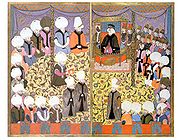
Calligraphy
Calligraphy is a type of visual art. It is often called the art of fancy lettering . A contemporary definition of calligraphic practice is "the art of giving form to signs in an expressive, harmonious and skillful manner"...
and miniatures. In the displays, one can see old and very precious Qur'an
Qur'an
The Quran , also transliterated Qur'an, Koran, Alcoran, Qur’ān, Coran, Kuran, and al-Qur’ān, is the central religious text of Islam, which Muslims consider the verbatim word of God . It is regarded widely as the finest piece of literature in the Arabic language...
s (12th-17th c.), hand-painted and hand-written in Kufic
Kufic
Kufic is the oldest calligraphic form of the various Arabic scripts and consists of a modified form of the old Nabataean script. Its name is derived from the city of Kufa, Iraq, although it was known in Mesopotamia at least 100 years before the foundation of Kufa. At the time of the emergence of...
, and also a bible
Bible
The Bible refers to any one of the collections of the primary religious texts of Judaism and Christianity. There is no common version of the Bible, as the individual books , their contents and their order vary among denominations...
from the 4th century, written in Arabic. A priceless item of this collection is the first world map
Piri Reis map
The Piri Reis map is a pre-modern world map compiled in 1513 from military intelligence by the Ottoman-Turkish admiral and cartographer Piri Reis. The half of the map that survives shows the western coasts of Europe and North Africa and the coast of Brazil with reasonable accuracy...
by the Turkish admiral Piri Reis
Piri Reis
Piri Reis was an Turkish Ottoman admiral, geographer and cartographer born between 1465 and 1470 and died in 1554 or 1555....
(1513). The map shows parts of the western coasts of Europe and North Africa with reasonable accuracy, and the coast of Brazil
Brazil
Brazil , officially the Federative Republic of Brazil , is the largest country in South America. It is the world's fifth largest country, both by geographical area and by population with over 192 million people...
is also easily recognizable. The upper part of the gallery contains 37 portraits of different sultans, most of which are copies since the original paintings are too delicate to be publicly shown. The portrait of Mehmed II was painted by the Venetian painter Gentile Bellini
Gentile Bellini
Gentile Bellini was an Italian painter. From 1474 he was the official portrait artist for the Doges of Venice.- Biography :...
. Other precious Ottoman miniature paintings that are either kept in this gallery, the palace library or in other parts are the Hünername, Sahansahname, the Sarayı Albums, Siyer-ı Nebi
Siyer-i Nebi
The Siyer-i Nebi is a Turkish epic about the life of Muhammad, completed around 1388, written by Mustafa son of Yusuf of Erzurum, known as al-Darir, a Mevlevi dervish on the commission of Sultan Berkuk, the Mamluk ruler in Cairo...
, Surname-ı Hümayun
Surname-I Hümayun
The Surname-I Hümayun literally translates into Imperial Festival Book, and were albums that commemorated celebrations in the Ottoman Empire in pictorial and textual detail. Such celebrations included mainly imperial weddings and circumcision festivals. These albums were commissioned by the Ottoman...
, Surname-ı Vehbi, and the Süleymanname among many others.
Enderûn Library (Library of Ahmed III)
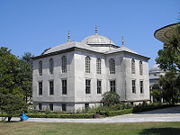

The library is a beautiful example of Ottoman architecture of the 18th century. The exterior of the building is faced with marble. The library has the form of a Greek cross with a domed central hall and three rectangular bays. The fourth arm of the cross consists of the porch, which can be approached by a flight of stairs on either side. Beneath the central arch of the portico is an elaborate drinking fountain with niches on each side. The building is set on a low basement to protect the precious books of the library against moisture.
The walls above the windows are decorated with 16th and 17th century İznik tiles of variegated design. The central dome and the vaults of the rectangular bays have been painted. The decoration inside the dome and vaults are typical of the so-called Tulip period, which lasted from 1703 to 1730. The books were stored in cupboards built into the walls. The niche opposite the entrance was the private reading corner of the sultan.
The library contained books on theology
Theology
Theology is the systematic and rational study of religion and its influences and of the nature of religious truths, or the learned profession acquired by completing specialized training in religious studies, usually at a university or school of divinity or seminary.-Definition:Augustine of Hippo...
, Islamic law and similar works of scholarship in Ottoman Turkish, Arabic and Persian. The library collection consisted of more than 3,500 manuscripts. Some are fine examples of inlay work with nacre and ivory. Today these books are kept in the Mosque of the Ağas (Ağalar Camii), which is located to the west of the library. One of the most important items there is the so-called Topkapi manuscript
Topkapi manuscript
The term Topkapi manuscript refers to an early manuscript of Quran dated to the 8th century. This manuscript is currently kept in the Topkapi Palace Museum, Istanbul, Turkey....
, a copy of the Qur'an from the time of the third Caliph Uthman Ibn Affan.
Mosque of the Ağas
The Mosque of the Ağas (Ağalar Camii) is the largest mosque in the palace. It is also one of the oldest constructions, dating from the 15th century during the reign of Mehmed II. The Sultan, the ağas and pages would come here to pray. The mosque is aligned in a diagonal line in the courtyard to make the minbarMinbar
A minbar is a pulpit in the mosque where the imam stands to deliver sermons or in the Hussainia where the speaker sits and lectures the congregation...
face Mecca. In 1928 the books of the Enderûn Library, among other works, were moved here as the Palace Library (Sarayı Kütüphanesi), housing a collection of about 13,500 Turkish, Arabic, Persian and Greek books and manuscripts, collected by the Ottomans. Located next to the mosque to the northeast is the Imperial Portraits Collection.
Dormitory of the Royal Pages

Mahmud II
Mahmud II was the 30th Sultan of the Ottoman Empire from 1808 until his death in 1839. He was born in the Topkapi Palace, Istanbul, the son of Sultan Abdulhamid I...
have realistic portraits of the rulers been made. An interesting feature is a large painted family tree
Family tree
A family tree, or pedigree chart, is a chart representing family relationships in a conventional tree structure. The more detailed family trees used in medicine, genealogy, and social work are known as genograms.-Family tree representations:...
of the Ottoman rulers. The domed chamber is supported by pillars, some of Byzantine origin since a cross is engraved on one of them.
Privy Chamber
The Privy ChamberPrivy chamber
A Privy chamber was the private apartment of a royal residence in England. The gentlemen of the Privy chamber were servants to the Crown who would wait and attend on the King and Queen at court during their various activities, functions and entertainments....
houses the Chamber of the Sacred Relics (Kutsal Emanetler Dairesi), which includes the Pavilion of the Holy Mantle. The chamber was constructed by Sinan under the reign of Sultan Murad III. It used to house offices of the Sultan.
It houses what are considered to be "the most sacred relics of the Muslim world": the cloak of the Prophet Muhammad, two swords, a bow, one tooth, a hair of his beard, his battle sabres, an autographed letter and other relic
Relic
In religion, a relic is a part of the body of a saint or a venerated person, or else another type of ancient religious object, carefully preserved for purposes of veneration or as a tangible memorial...
s which are known as the Sacred Trusts
The Sacred Trusts
The Islamic Sacred Relics , also known as the Holy Relics, consist of religious pieces sent to the Ottoman Sultans between the 16th century to the late 19th century....
. Several other sacred objects are on display, such as the swords of the first four Caliph
Caliph
The Caliph is the head of state in a Caliphate, and the title for the ruler of the Islamic Ummah, an Islamic community ruled by the Shari'ah. It is a transcribed version of the Arabic word which means "successor" or "representative"...
s, The Staff of Moses
The Staff of Moses
According to the Book of Exodus in the Bible, the staff used by Moses was by his side throughout important milestones in the narrative...
, the turban of Joseph
Joseph (Hebrew Bible)
Joseph is an important character in the Hebrew bible, where he connects the story of Abraham, Isaac and Jacob in Canaan to the subsequent story of the liberation of the Israelites from slavery in Egypt....
and a carpet of the daughter of Mohammed. Even the Sultan and his family were permitted entrance only once a year, on the 15th day of Ramadan
Ramadan
Ramadan is the ninth month of the Islamic calendar, which lasts 29 or 30 days. It is the Islamic month of fasting, in which participating Muslims refrain from eating, drinking, smoking and sex during daylight hours and is intended to teach Muslims about patience, spirituality, humility and...
, during the time when the palace was a residence. Now any visitor can see these items, although in very dim light to protect the relics, and many Muslims make a pilgrimage
Pilgrimage
A pilgrimage is a journey or search of great moral or spiritual significance. Typically, it is a journey to a shrine or other location of importance to a person's beliefs and faith...
for this purpose.
The Arcade of the Chamber of the Holy Mantle was added in the reign of Murad III, but was altered when the Circumcision Room was added. This arcade may have been built on the site of the Temple of Poseidon
Poseidon
Poseidon was the god of the sea, and, as "Earth-Shaker," of the earthquakes in Greek mythology. The name of the sea-god Nethuns in Etruscan was adopted in Latin for Neptune in Roman mythology: both were sea gods analogous to Poseidon...
that was transformed before the 10th century into the Church of St. Menas.
The Privy Chamber was converted into an accommodation for the officials of the Mantle of Felicity in the second half of the 19th century by adding a vault to the colonnades of the Privy Chamber in the Enderun Courtyard.
Harem
.svg.png)

Imperial Harem
The Imperial Harem of the Ottoman Empire was one of the most important elements of the Ottoman court. It was known in the West as "the Seraglio", an Italian term.- Harem quarters:...
(Harem-i Hümayûn) occupied one of the sections of the private apartments of the sultan; it contained more than 400 rooms. The harem was home to the sultan's mother, the Valide Sultan
Valide Sultan
Valide Sultan was the title held by the mother of a ruling Sultan in the Ottoman Empire. The Turkish pronunciation of the word Valide is . The title is sometimes translated as Queen Mother, although the position of Valide Sultan was quite different.The position was perhaps the most important...
; the concubines and wives of the sultan; and the rest of his family, including children; and their servants. The harem consists of a series of buildings and structures, connected through hallways and courtyards. Every service team and hierarchical group residing in the harem had its own living space clustered around a courtyard. The number of rooms is not determined, with probably over 100, of which only a few are open to the public. These apartments (Daires) were occupied respectively by the harem eunuchs, the Chief Harem Eunuch (Darüssaade Ağası), the concubines, the queen mother, the sultan's consorts, the princes and the favourites. There was no trespassing beyond the gates of the harem, except for the sultan, the queen mother, the sultan's consorts and favourites, the princes and the concubines as well as the eunuchs guarding the harem.
The harem wing was only added at the end of the 16th century. Many of the rooms and features in the Harem were designed by Mimar Sinan. The harem section opens into the Second Courtyard (Divan Meydanı), which the Gate of Carriages (Arabalar Kapısı) also opens to. The structures expanded over time towards the Golden Horn side and evolved into a huge complex. The buildings added to this complex from its initial date of construction in the 15th century until the early 19th century capture the stylistic development of palace design and decoration. Parts of the harem were redecorated under the sultans Mahmud I
Mahmud I
Mahmud I , called the Hunchback was the Sultan of the Ottoman Empire from 1730 to 1754.-Biography:...
and Osman III
Osman III
Osman III or Othman IIIText not available was the Sultan of the Ottoman Empire from 1754 to 1757.-Biography:...
in an Italian-inspired Ottoman Baroque style. These decorations contrast with those of the Ottoman classical age.
Gate of Carts / Domed Cupboard Chamber
The entrance gate from the Second Courtyard is the Gate of Carts (Arabalar Kapısı), which leads into the Domed Cupboard Room (Dolaplı Kubbe). This place was built as a vestibule to the harem in 1587 by Murad III. The harem treasury worked here. In its cupboards, records of deedDeed
A deed is any legal instrument in writing which passes, or affirms or confirms something which passes, an interest, right, or property and that is signed, attested, delivered, and in some jurisdictions sealed...
s of trust were kept, administered by the Chief Harem Eunuch. This treasury stored money from the pious foundations of the harem and other foundations, and financial records of the sultans and the imperial family.
Hall of the Ablution Fountain
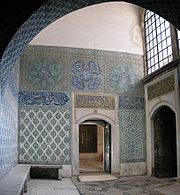
The walls are riveted with 17th century Kütahya
Kütahya
Kütahya is a city in western Turkey with 212,444 inhabitants , lying on the Porsuk river, at 969 metres above sea level. It is the capital of Kütahya Province, inhabited by some 517 804 people...
tiles.
The horse block in front of the mosque served the sultan to mount his horse and the sitting benches were for the guards.
The fountain that gives the space its name was moved and is now in the pool of the Privy Chamber of Murad III.
On the left is the small mosque of the black eunuchs. The tiles in watery green, dirty white and middle blue all date from the 17th century (reign of Mehmed IV
Mehmed IV
Mehmed IV Modern Turkish Mehmet was the Sultan of the Ottoman Empire from 1648 to 1687...
). Their design is of a high artistic level but the execution is of minor quality compared to 16th century tiles, and the paint on these tiles blurs.
Courtyard of the Eunuchs
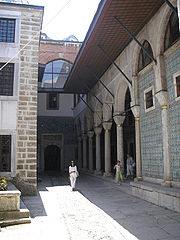
Odalisque
An odalisque was a female slave in an Ottoman seraglio. She was an assistant or apprentice to the concubines and wives, and she might rise in status to become one of them...
s (white slaves given as a gift to the sultan).
Many of the eunuchs’ quarters face this courtyard, which is the first one of the Harem, since they also acted as guards under the command of the Chief Harem Eunuch.
The spaces surrounding this courtyard were rebuilt after the great fire of 1665. The complex includes the dormitory of the Harem eunuchs behind the portico, the quarters of the Chief Harem Eunuch (Darüssaade Ağası) and the School of Princes as well as the Gentlemen-in-Waiting of the Sultan (Musahipler Dairesi) and the sentry post next to it. The main entrance gate of the Harem and the gate of the Kuşhane connected the Enderûn court leads out into the Kuşhane door.
The dormitories of the Harem eunuchs (Harem Ağaları Koğuşu) date to the 16th century. They are arranged around an inner courtyard in three storys.
The inscription on the facade of the dormitory includes the deeds of trust of the Sultans Mustafa IV, Mahmud II and Abdül Mecid I dating from the 19th century.
The rooms on the upper stories were for novices and those below overlooking the courtyard were occupied by the eunuchs who had administrative functions.
There is a monumental fireplace revetted with the 18th century Kütahya tiles at the far end.
The Chief Harem Eunuch's apartment (Darüssaade Ağasi Dairesi) adjacent to the dormitory contains a bath, living rooms and bedrooms.
The school room of the princes under the control of the Chief Harem eunuch was on the upper story.
The walls were revetted with 18th century European tiles with baroque decorations.
Harem main entrance
The main entrance (Cümle Kapisi) separates the harem in which the family and the concubines of the sultan resided from the Courtyard of the Eunuchs. The door leads out into the sentry post (Nöbet Yeri) to which the three main sections of the harem are connected. The door on the left of the sentry post leads through the Passage of the Concubines to the Court of the Concubines (Kadınefendiler Taşlığı). The door in the middle leads to the Court of the Queen Mother (Valide Taşlığı) and the door to the right leads through the Golden Road (Altınyol) to the sultan's quarters. The large mirrors in this hall date from the 18th century.Courtyard of the Queen Mother
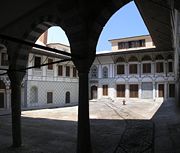
Passage of Concubines
The Passage of Concubines (Cariye Koridoru) leads into the Courtyard of the Sultan's Chief Consorts and Concubines.On the counters along the passage, the eunuchs placed the dishes they brought from the kitchens in the palace.
Courtyard of the Sultan's Consorts and the Concubines
It underwent restoration after the 1665 fire and is the smallest courtyard of the Harem.
The porticoed courtyard is surrounded by baths (Cariye Hamamı), a laundry fountain, a laundry, dormitories, the apartments of the Sultan's chief consort and the apartments of the stewardesses (Kalfalar Dairesi).
The three independent tiled apartments with fireplaces overlooking the Golden Horn
Golden Horn
The Golden Horn is a historic inlet of the Bosphorus dividing the city of Istanbul and forming the natural harbor that has sheltered Greek, Roman, Byzantine, Ottoman and other ships for thousands of...
were the quarters where the consorts of the Sultan lived. These constructions covered the site of the courtyard in the late 16th century.
At the entrance to the quarters of the Queen Mother, wall frescoes from the late 18th century depict landscapes, reflecting the western influence.
The staircase, called the "Forty Steps" (Kirkmerdiven), leads to the Hospital of the Harem (Harem Hastanesi), the dormitories of the concubines at the basement of the Harem and Harem Gardens.
Apartments of the Queen Mother

Only two of these rooms are open to the public: the dining room with, in the upper gallery, the reception room and her bedroom with, behind a lattice work, a small room for prayer. On the lower stories of the apartments are the quarters of the concubines, while the upper story rooms are those of the Queen Mother and her ladies-in-waiting (kalfas). The apartments of the Queen Mother are connected by a passage, leading into the Queen Mother's bathroom, to the quarters of the sultan.
These are all enriched with blue-and-white or yellow-and-green tiles with flowery motifs and İznik porcelain from the 17th century. The panel representing Mecca
Mecca
Mecca is a city in the Hijaz and the capital of Makkah province in Saudi Arabia. The city is located inland from Jeddah in a narrow valley at a height of above sea level...
or Medina
Medina
Medina , or ; also transliterated as Madinah, or madinat al-nabi "the city of the prophet") is a city in the Hejaz region of western Saudi Arabia, and serves as the capital of the Al Madinah Province. It is the second holiest city in Islam, and the burial place of the Islamic Prophet Muhammad, and...
, signed by Osman İznikli Mehmetoğlu, represents a new style in İznik tiles. The paintwork with panoramic views in the upper rooms is in the Western European style of the 18th and 19th century.
Situated on top of the apartments of the Queen Mother are the apartments of Mihirisah in the rococo style.
Leading from the apartments to the baths lays the apartment of Abdül Hamid I. Close to that is Selim's III love chamber constructed in 1790. A long, narrow corridor connects this to the kiosk of Osman III dated to 1754.
Baths of the Sultan and the Queen Mother

Caldarium
right|thumb|230px|Caldarium from the Roman Baths at [[Bath, England]]. The floor has been removed to reveal the empty space where the hot air flowed through to heat the floor....
, a tepidarium
Tepidarium
The tepidarium was the warm bathroom of the Roman baths heated by a hypocaust or underfloor heating system.The specialty of a tepidarium is the pleasant feeling of constant radiant heat which directly affects the human body from the walls and floor.There is an interesting example at Pompeii; this...
and a frigidarium
Frigidarium
A frigidarium is a large cold pool of Roman baths. It would be entered after the Caldarium and the Tepidarium, which were used to open the pores of the skin. The cold water would close the pores. There would be a small pool of cold water or sometimes a large Swimming pool...
. Each room either has a dome, or the ceilings are at some point glassed in a honeycomb
Honeycomb
A honeycomb is a mass of hexagonal waxcells built by honey bees in their nests to contain their larvae and stores of honey and pollen.Beekeepers may remove the entire honeycomb to harvest honey...
structure to let the natural sunlight in. The floor is clad in white and grey marble. The marble tub with an ornamental fountain in the caldarium and the gilded iron grill are characteristic features. The golden lattice work was to protect the bathing sultan or his mother from murder attempts. The sultan's bath was decorated by Sinan with high-quality İznik polychrome tiles. But much of the tile decoration of the harem, from structures damaged by the fire of 1574, was recycled by Sultan Ahmed I
Ahmed I
Ahmed I or Ahmed Bakhti was the Sultan of the Ottoman Empire from 1603 until his death in 1617.-Biography:...
for decoration in his new Sultan Ahmed Mosque
Sultan Ahmed Mosque
The Sultan Ahmed Mosque is a historical mosque in Istanbul, the largest city in Turkey and the capital of the Ottoman Empire . The mosque is popularly known as the Blue Mosque for the blue tiles adorning the walls of its interior....
in Istanbul. The walls are now either clad in marble or white-washed.
Imperial Hall
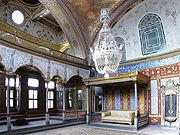
After the Great Harem Fire of 1666, the hall was renovated in the rococo style during the reign of Sultan Osman III. The tile belt surrounding the walls bearing calligraphic inscriptions were riveted with 18th century blue and white Delftware
Delftware
Delftware, or Delft pottery, denotes blue and white pottery made in and around Delft in the Netherlands and the tin-glazed pottery made in the Netherlands from the 16th century....
and mirrors of Venetian glass
Venetian glass
Venetian glass is a type of glass object made in Venice, Italy, primarily on the island of Murano. It is world-renowned for being colourful, elaborate, and skillfully made....
. But the domed arch and pendantives still bear classical paintings dating from the original construction.
In the hall stands the sultan's throne. The gallery was occupied by the consorts of the sultan, headed by the Queen Mother. The gilded chairs are a present of Emperor Wilhelm II of Germany, while the clocks are a gift of Queen Victoria of the United Kingdom
Victoria of the United Kingdom
Victoria was the monarch of the United Kingdom of Great Britain and Ireland from 20 June 1837 until her death. From 1 May 1876, she used the additional title of Empress of India....
. A pantry, where musical instruments are exhibited, opens to the Imperial Hall, which provides access into the sultan's private apartments.
A secret door behind a mirror allowed the sultan a safe passage. One door admits to the Queen Mother’s apartments, another to the sultan's hammam. The opposite doors lead to the small dining chamber (rebuilt by Ahmed III) and the great bedchamber, while the other admits to a series of ante-chambers, including the room with the fountain (Çeşmeli Sofa), which were all retiled and redecorated in the 17th century.
Privy Chamber of Murat III
The Privy Chamber of Murat III (III. Murad Has Odası) is the oldest and finest surviving room in the harem, having retained its original interior. It was a design of the master architect Sinan and dates from the 16th century. Its dome is only slightly smaller than that of the Throne Room. Its hall has one of the finest doors of the palace and leads past the wing of the crown princes (Kafes). The room is decorated with blue-and-white and coral-red İznik tiles. The rich floral designs are framed in thick orange borders of the 1570s. A band of inscriptional tiles runs around the room above the shelf and door level. The large arabesqueArabesque
The arabesque is a form of artistic decoration consisting of "surface decorations based on rhythmic linear patterns of scrolling and interlacing foliage, tendrils" or plain lines, often combined with other elements...
patterns of the dome have been regilded and repainted in black and red. The large fireplace with gilded hood (ocak) stands opposite a two-tiered fountain (çeşme), skilfully decorated in coloured marble. The flow of water was meant to prevent any eavesdropping, while providing a relaxed atmosphere to the room. The two gilded baldachin beds date from the 18th century.
Privy Chamber of Ahmed I
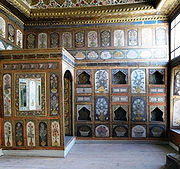
Privy Chamber of Ahmed III
Next to it is the small but very colourful Privy Chamber of Ahmed III (III. Ahmed Has Odası) with walls painted with panels of floral designs and bowls of fruit and with an intricate tiles fireplace (ocak). This room is therefore also known as the Fruit Room (Yemis Odası) and was probably used for dining purposes.Twin Kiosk / Apartments of the Crown Prince

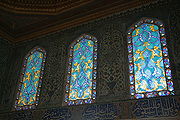
The interior consists of two large rooms, dating from the reign of Sultan Murat III, but are more probably from the reign of Ahmed I. The ceiling is not flat but conical in the kiosk style, evoking the traditional tents of the early Ottomans. As in tents, there is no standing furniture but sofas set on the carpeted floor on the side of the walls for seating.
These chambers represent all the details of the classical style used in other parts of the palace.
The pavilion has been completely redecorated, and most of the Baroque woodwork has been removed. The decorative tiles, reflecting the high quality craftsmanship of the İznik tile industry of the 17th century, were removed in accordance with the original concept and replaced with modern copies. The paintwork of the wooden dome is still original and is an example of the rich designs of the late 16th/early 17th centuries. The fireplace in the second room has a tall, gilded hood and has been restored to its original appearance. The window shutters next to the fireplace are decorated with nacre
Nacre
Nacre , also known as mother of pearl, is an organic-inorganic composite material produced by some mollusks as an inner shell layer; it is also what makes up pearls. It is very strong, resilient, and iridescent....
intarsia
Intarsia
Intarsia is a form of wood inlaying that is similar to marquetry. The term is also used for a similar technique used with small, highly polished stones set in a marble matrix .- History :...
. The windows in coloured glass look out across the high terrace and the garden of the pool below. The spigots in these windows are surrounded with red, black and gold designs.
The crown prince (Şehzadeler) lived here in seclusion; therefore, the apartments were also called kafes
Kafes
Kafes, literally "the cage", was the part of the Imperial Harem of the Ottoman Palace where possible successors to the throne were kept under a form of house-arrest and constant surveillance by the palace guards....
(cage). The crown prince and other princes were trained in the discipline of the Ottoman Harem until they reached adulthood. Afterwards, they were sent as governors to Anatolia
Anatolia
Anatolia is a geographic and historical term denoting the westernmost protrusion of Asia, comprising the majority of the Republic of Turkey...
n provinces, where they were further trained in the administration of state affairs. From the beginning of the 17th century onward, the princes lived in the Harem, which started to have a voice in the palace administration. The Twin Kiosk was used as the privy chamber of the crown prince from the 18th century onward.
Courtyard of the Favourites

The favourites of the sultan (Gözdeler / İkballer) were conceived as the instruments of the perpetuation of the dynasty in the harem organisation. When the favourites became pregnant they assumed the title and powers of the official consort (Kadınefendi) of the sultan.
Golden Road
The Golden Road (Altınyol) is a narrow passage that forms the axis of the Harem, dating from the 15th century. It extends between the Courtyard of the Harem Eunuch (Harem Ağaları Taşlığı) and the Privy Chamber (Has Oda).The sultan used this passage to pass to the Harem, the Privy Chamber and the Sofa-i Hümâyûn, the Imperial terrace.
The Courtyard of the Queen Mother (Valide Sultan Taşlığı’), the Courtyard of the Chief Consort of the Sultan (Baş Haseki), the apartments of the Princes (Şehzadegân Daireleri), and the apartments of the Sultan (Hünkâr Dairesi) open to this passage. The walls are painted a plain white colour.
It is believed that the attribute "golden" is due to the sultan's throwing of golden coins to be picked up by the concubines at festive days, although this is disputed by some scholars.
Aviary / Harem Gate
Until the late 19th century, there had been a small inner court in this corner of the Enderûn Courtyard. This court led through the Kuşhane Gate into the harem. Today this is the gate from which the visitors exit from the Harem. Birds were raised for the sultan's table in the buildings around the gate. On the inscription over the Kuşhane door one reads that Mahmud I had the kitchen of the Kuşhane repaired. The balcony of the aviary facing the Harem Gate was constructed during repair work in 1916. The building's facade resembles traditional aviariesAviary
An aviary is a large enclosure for confining birds. Unlike cages, aviaries allow birds a larger living space where they can fly; hence, aviaries are also sometimes known as flight cages...
.
Fourth Courtyard
The Fourth Courtyard (IV. Avlu), also known as the Imperial Sofa (Sofa-ı Hümâyûn), was more of an innermost private sanctuary of the sultan and his family, and consists of a number of pavilions, kioskKiosk
Kiosk is a small, separated garden pavilion open on some or all sides. Kiosks were common in Persia, India, Pakistan, and in the Ottoman Empire from the 13th century onward...
s (köşk), gardens and terraces. It was originally a part of the Third Courtyard but recent scholars have identified it as more separate to better distinguish it.
Circumcision Room
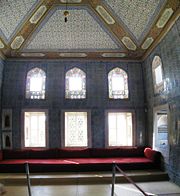
Ibrahim I
Ibrahim I was the Sultan of the Ottoman Empire from 1640 until 1648. He was born in Istanbul the son of Ahmed I by Valide Sultan Kadinefendi Kösem Sultan, an ethnic Greek originally named Anastasia...
added the Circumcision Room (Sünnet Odası), a summer kiosk (Yazlik Oda) dedicated to the circumcision
Circumcision
Male circumcision is the surgical removal of some or all of the foreskin from the penis. The word "circumcision" comes from Latin and ....
of young princes, which is a primary rite of passage
Rite of passage
A rite of passage is a ritual event that marks a person's progress from one status to another. It is a universal phenomenon which can show anthropologists what social hierarchies, values and beliefs are important in specific cultures....
in Islam
Islam
Islam . The most common are and . : Arabic pronunciation varies regionally. The first vowel ranges from ~~. The second vowel ranges from ~~~...
. Its interior and exterior are decorated with a mixed collection of rare recycled tiles such as the blue tiles with flower motifs at the exterior. The most important of these are the blue and white tile panels influenced by far-eastern ceramics on the chamber facade, dated 1529. These once embellished ceremonial buildings of Sultan Suleiman I, such as the building of the Council Hall and the Inner Treasury (both in the Second Courtyard) and the Throne Room (in the Third Courtyard). They were moved here out of nostalgia and reverence for the golden age of his reign. These tiles then served as prototypes for the decoration of the Yerevan and Baghdad kiosks. The room itself is symmetrically proportioned and relatively spacious for the palace, with windows, each with a small fountain. The windows above contain some stained-glass panels. On the right side of the entrance stands a fireplace with a gilded hood. Sultan Ibrahim also built the arcaded roof around the Chamber of the Holy Mantle and the upper terrace between this room and the Baghdad kiosk.
The royal architect Hasan Ağa under Sultan Murat IV constructed during 1635-1636 the Yerevan Kiosk (Revan Köşkü) and in 1638-1639 the Baghdad Kiosk (Bağdat Köşkü) to celebrate the Ottoman victories at Yerevan
Yerevan
Yerevan is the capital and largest city of Armenia and one of the world's oldest continuously-inhabited cities. Situated along the Hrazdan River, Yerevan is the administrative, cultural, and industrial center of the country...
and Baghdad
Baghdad
Baghdad is the capital of Iraq, as well as the coterminous Baghdad Governorate. The population of Baghdad in 2011 is approximately 7,216,040...
. Both contain most of their original decoration, with projecting eaves, a central dome and interior with recessed cupboards and woodwork with inlaid nacre
Nacre
Nacre , also known as mother of pearl, is an organic-inorganic composite material produced by some mollusks as an inner shell layer; it is also what makes up pearls. It is very strong, resilient, and iridescent....
tesserae. Both are based on the classical four-iwan
Iwan
An iwan is a rectangular hall or space, usually vaulted, walled on three sides, with one end entirely open. The formal gateway to the iwan is called pishtaq, a Persian term for a portal projecting from the facade of a building, usually decorated with calligraphy bands, glazed tilework, and...
plan with sofas filling the rectangular bays.
Yerevan Kiosk
_-_foto_g._dallorto_27-5-2006.jpg)
Baghdad Kiosk
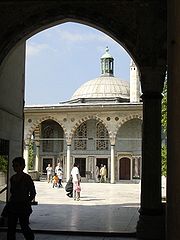
It closely resembles the Yerevan Kiosk. The three doors to the porch are located between the sofas. The façade is covered with marble, strips of porphyry
Porphyry (geology)
Porphyry is a variety of igneous rock consisting of large-grained crystals, such as feldspar or quartz, dispersed in a fine-grained feldspathic matrix or groundmass. The larger crystals are called phenocrysts...
and verd antique
Verd antique
Verd antique , or verde antique, is a serpentinite breccia popular since ancient times as a decorative facing stone. It is a dark, dull green, white-mottled serpentine, mixed with calcite, dolomite, or magnesite, which takes a high polish...
. The marble panelling of the portico is executed in Cairene Mamluk style. The interior is an example of an ideal Ottoman room. The recessed shelves and cupboards are decorated with early 16th century green, yellow and blue tiles. The blue-and-white tiles on the walls are copies of the tiles of the Circumcision Room, right across the terrace. With its tiles dating to the 17th century, mother-of-pearl, tortoise-shell decorated cupboard and window panels, this pavilion is one of the last examples of the classical palace architecture.
The doors have very fine inlay work. On the right side of the entrance is a fireplace with a gilded hood. In the middle of the room is a silver 'mangal' (charcoal stove), a present of King Louis XIV of France
Louis XIV of France
Louis XIV , known as Louis the Great or the Sun King , was a Bourbon monarch who ruled as King of France and Navarre. His reign, from 1643 to his death in 1715, began at the age of four and lasted seventy-two years, three months, and eighteen days...
. From the mid-18th century onwards, the building was used as the library of the Privy Chamber.
İftar Pavilion
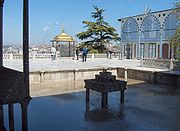
Ramadan
Ramadan is the ninth month of the Islamic calendar, which lasts 29 or 30 days. It is the Islamic month of fasting, in which participating Muslims refrain from eating, drinking, smoking and sex during daylight hours and is intended to teach Muslims about patience, spirituality, humility and...
after sunset. Some sources mention this resting place as the "Moonlit Seat". Special gifts like the showering of gold coins to officials by the sultan also sometimes occurred here. The marbled terrace gained its current appearance during the reign of Sultan Ibrahim (1640–48).
Terrace Kiosk
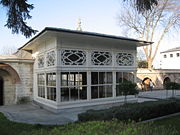
Belvedere (structure)
Belvedere is an architectural term adopted from Italian , which refers to any architectural structure sited to take advantage of such a view. A belvedere may be built in the upper part of a building so as to command a fine view...
built in the second half of the 16th century. It was restored in 1704 by Sultan Ahmed III and rebuilt in 1752 by Mahmud I in the Rococo style. It is the only wooden building in the innermost part of the palace. It consists of rooms with the backside supported by columns.
The kiosk consists of the main hall called Divanhane, the prayer room (Namaz Odası or Şerbet Odası) and the Room for Sweet Fruit Beverages. From the kiosk the sultan would watch sporting events in the garden and organised entertainments. This open building with large windows was originally used as a restroom and later, during the Tulip era (1718–1730), as a lodge for guests. It is situated next to the Tulip Garden.
Tower of the Head Tutor / Chamber of the Chief Physician
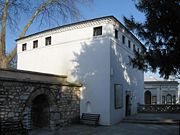
The first court pharmacy was established during the reign of Mehmed II. There were also other pharmacies and infirmaries at the palace besides this particular one. According to a legend, Enderunlu Tayyar Efendi, who was the Chief Tutor (Baş Lala) during the reign of Sultan Selim III, saw from the upper floor of this tower the rebels coming to the palace to assassinate the sultan and alarmed the sultan's loyalists. The historian Afa writes that the tower was more than two floors higher than today but today it only has two storeys left.
The Chief Physician (Hekim Başı) and the Chief Tutor shared this place as their residence. The Chief Physician was responsible for the health of the sultan and the imperial family and used to prepare the medicines here. Under his supervision and those of the chief tutor the palace drugs were prepared, mixed and sealed in bottles, jars, boxes or bowls and given to the patients.
The Chief Physician was also a companion of the sultan outside the palace, accompanying him even on battles. The office of the chief physician was traditionally held by Jews. After the 17th century, there were increasingly Muslim physicians along with Jewish and European physicians. The last Chief Physician was Abdülhak Molla, who lived during the reign of Sultan Abdülmecid I. After the sultan moved away from Topkapı, the tower was used as a music conservatory and later used for the cleaning of palace arms. It was restored in 1911 and houses the medical objects collection.
Stone throne
A stone throne (Taş That) was made for Murad IV to watch the sports activities of pages. The inscription on the throne states that in 1636 Murad IV, who was an accomplished sportsman himself, threw an oak cudgel 120 meters while riding his horse.Grand Kiosk
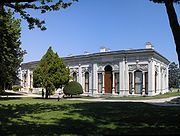
Eclecticism in art
Eclecticism is a kind of mixed style in the fine arts: "the borrowing of a variety of styles from different sources and combining them" . Significantly, Eclecticism hardly ever constituted a specific style in art: it is characterized by the fact that it was not a particular style...
Europeanized style, mixed with traditional Ottoman style. Inside it is furnished in the Empire style. The two buildings were also used occasionally to accommodate foreign guests.

Elizabeth II of the United Kingdom
Elizabeth II is the constitutional monarch of 16 sovereign states known as the Commonwealth realms: the United Kingdom, Canada, Australia, New Zealand, Jamaica, Barbados, the Bahamas, Grenada, Papua New Guinea, the Solomon Islands, Tuvalu, Saint Lucia, Saint Vincent and the Grenadines, Belize,...
, First Lady Jackie Kennedy, President Richard Nixon
Richard Nixon
Richard Milhous Nixon was the 37th President of the United States, serving from 1969 to 1974. The only president to resign the office, Nixon had previously served as a US representative and senator from California and as the 36th Vice President of the United States from 1953 to 1961 under...
, and boxer Mohammed Ali
Muhammad Ali
Muhammad Ali is an American former professional boxer, philanthropist and social activist...
, among many others. The terrace of the restaurant offers a panoramic view of the Bosphorus and the Asian side. Most tourists come here to take pictures of the sea and the city.
Terrace Mosque
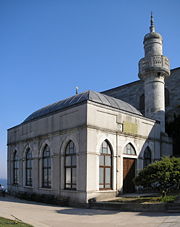
Outer gardens
Surrounding the whole complex of the First to the Fourth Courtyard are the outer palace gardens. A part of this area that is facing the sea is also known as the Fifth Place. When the railway lines leading to the Sirkeci railway station were constructed in the late 19th century, the Shore KioskShore Kiosk
The Shore Kiosk was a structure directly located at the banks of the Bosphorus, Istanbul, and served as a pleasure building for the Ottoman Padishah.- Literature :* Fanny Davis. Palace of Topkapi in Istanbul. 1970. ASIN B000NP64Z2...
, the Pearl Kiosk
Pearl Kiosk
The Pearl Kiosk was a structure directly located at the banks of the Bosphorus and served as a pleasure building for the Ottoman Padishah.- Literature :* Fanny Davis. Palace of Topkapi in Istanbul. 1970. ASIN B000NP64Z2...
and the Marble Kiosk
Marble Kiosk
The Marble Kiosk was a structure directly located at the banks of the Bosphorus of Topkapı Palace in Istanbul, and served as a pleasure building for the Ottoman Padishah. It was located next to the Cannon Gate , both structures are today lost....
. A fourth seaside kiosk remains today, namely the Basketmakers' Kiosk
Basketmakers' Kiosk
The Basketmakers' Kiosk , also known as Sepetçiler Palace , is a former Ottoman pleasure palace located on the southern shore of Golden Horn's mouth at Sarayburnu in the neighborhood of Sirkeci in Istanbul, Turkey.- History :...
.
Located next to the First Courtyard towards the city lies the Gülhane Park
Gülhane Park
Gülhane Park is a historical urban park in the Eminönü district of Istanbul, Turkey, located adjacent to and on the grounds of the Topkapı Palace; the south entrance of the park sports one of the larger gates of the palace...
, the old imperial rose garden. This park is open to the public. Located at the gate to the park is the Procession Kiosk
Procession Kiosk
The Procession Kiosk is a structure directly located next to Gülhane Park in Istanbul, Turkey which served as a pleasure building for the Ottoman Padishah. It is located in close proximity to the Sublime Porte....
.
Mehmed II also had three pavilions, or kiosks, constructed, of which only the Tiled Kiosk
Tiled Kiosk
The Tiled Kiosk is a pavilion set within the outer walls of Topkapı Palace and dates from 1473. It was built by the Ottoman sultan Mehmed II as a pleasure palace or kiosk. It is located in the most outer parts of the palace, next to Gülhane Park...
(Çinili Köşkü) has survived. The Tiled Pavilion dates to around 1473 and houses the Islamic ceramics collection of the Istanbul Archaeology Museums.
Trees

Fungus
A fungus is a member of a large group of eukaryotic organisms that includes microorganisms such as yeasts and molds , as well as the more familiar mushrooms. These organisms are classified as a kingdom, Fungi, which is separate from plants, animals, and bacteria...
that has completely hollowed out their trunks, over the course of centuries. The trees nonetheless survive and remain standing. In other cases, two trees of a different kind have grown and fused together, such as a fig tree that grew in the hollow of another tree and effectively fused with it. This phenomenon can be seen in the second courtyard.
Security concerns
The palace has been deemed lax on security and preservation by some experts, who point out that the palace has no climate-controlled rooms or storage and is a "security nightmare."Since many of the walls of the palace are ten feet thick, it mostly escaped structural damage during the 1999 İzmit earthquake
1999 Izmit earthquake
The 1999 İzmit earthquake was a 7.6 magnitude earthquake that struck northwestern Turkey on August 17, 1999, at about 3:02am local time. The event lasted for 37 seconds, killing around 17,000 people and leaving approximately half a million people homeless...
. Following this catastrophe, the museum director placed the porcelain collection on more secure mounts in the palace.
During a 1999 robbery, thieves stole portions of a 12th-century Qur'an from a locked exhibit in the library.
Copies
The resort hotel World Of Wonders Resorts & Hotels Topkapi Palace in AntalyaAntalya
Antalya is a city on the Mediterranean coast of southwestern Turkey. With a population 1,001,318 as of 2010. It is the eighth most populous city in Turkey and country's biggest international sea resort.- History :...
is a reconstruction of some of the buildings, such as the Audience Chamber, the palace kitchens and the Tower of Justice.
See also
- Dolmabahçe PalaceDolmabahçe PalaceDolmabahçe Palace located in the Beşiktaş district of Istanbul, Turkey, on the European coastline of the Bosphorus strait, served as the main administrative center of the Ottoman Empire from 1856 to 1922, apart from a 22-year interval in which Yıldız Palace was used.- History :Dolmabahçe Palace...
– Imperial residence from 1853 until 1889, and from 1909 until 1922 - Yıldız PalaceYildiz PalaceYıldız Palace is a vast complex of former imperial Ottoman pavilions and villas in Istanbul, Turkey, built in the 19th and early 20th centuries. It was used as a residence by the Sultan and his court in the late 19th century.- Origin :...
– Imperial residence from 1889 until 1909 - Ottoman architecture
- State organisation of the Ottoman EmpireState organisation of the Ottoman EmpireThe Ottoman Empire developed a highly advanced organisation of state over the centuries. Even though it had a very centralized government with the Sultan as the supreme ruler, it had an effective control of its provinces and inhabitants, as well as its officials. Wealth and rank wasn't necessarily...
- Military of the Ottoman EmpireMilitary of the Ottoman EmpireThe history of military of the Ottoman Empire can be divided in five main periods. The foundation era covers the years between 1300 and 1453 , the classical period covers the years between 1451 and 1606 , the reformation period covers the years between 1606 and 1826 ,...
Literature
- Turhan Can, Topkapi Palace, Orient Turistik Yayinlar Ve Hizmetler Ltd., Istanbul, 1994;
- Turner, J. (ed.) - Grove Dictionary of ArtGrove Dictionary of ArtGrove Art Online, formerly The Dictionary of Art but usually known as The Grove Dictionary of Art, is a large encyclopedia of art, now part of the online reference publications of Oxford University Press, and previously a 34-volume printed encyclopedia when last published on paper in 1996...
- Oxford University Press, USA; New edition (January 2, 1996); ISBN 0-19-517068-7 - Topkapi Palace Museum. The Imperial Treasury. MAS Publications. 2001. ISBN 975-7710-04-0
- Ahmet ErtuğAhmet ErtuğAhmet Ertuğ is a fine art photographer and publisher based in Istanbul, Turkey.He was trained as an architect at the Architectural Association School of Architecture in London. He specializes in large format photography of architectural and archaeological edifices of theHellenistic, Roman,...
. Topkapi: The Palace of Felicity. Ertug & Kokabiyik. 1989. ASIN B0006F4CM6 - Tahsin Oz. Topkapi Saray Museum 50 Masterpieces. Turkish Press. ASIN B000VHIQCG
- J. M. Rogers. The Topkapi Saray Museum. Architecture; the Harem and other buildings. New York Graphic Society. 1988. ASIN B000MKDDF2
- Hulya Tezcan, J. M. Rogers. The Topkapi Saray Museum: Textiles. Bulfinch Press. 1986. ISBN 978-0-8212-1634-7
- J. M. Rogers (Author), Cengiz Koseoglu. Topkapi Saray Museum. Bulfinch Press. 1988. ISBN 978-0-8212-1672-9
- Filiz Pcafgman (Author), J. M. Rogers. The Topkapi Saray Museum: Manuscripts. Bulfinch Press. 1986. ISBN 978-0-8212-1633-0
- Regina Krahl (Author), Nurdan Erbahar (Author), John Ayers (Author). Chinese Ceramics in Topkapi Saray Museum, Istanbul: A Complete Catalogue. Sotheby Parke Bernet Publications. 1986. ISBN 978-0-85667-184-5
- Zeynep M. Durukan. The Harem of the Topkapi Palace. Hilal Matbaacilik Koll. 1973. ASIN B000OLCZPI
- Esin Atil. Suleymanname: The Illustrated History of Suleyman the Magnificent. Harry N Abrams. 1986. ISBN 978-0-8109-1505-3
- Fanny Davis. Palace of Topkapi in Istanbul. 1970. ASIN B000NP64Z2
- Turhan Can. Topkapi Palace. Orient Touristic Publishing Service. 1997. ASIN B000JERAEQ
- Sabahattin Turkoglu. The Topkapi Palace. NET. 1989. ISBN 978-975-479-074-0
- Ilhan Aksit. Topkapi Palace. Istanbul. 1994. ASIN B000MPGBGK
- Ergun, Nilgün, and Özge İskender. 2003. Gardens of the Topkapi Palace: An example of Turkish garden art. Studies in the History of Gardens & Designed Landscapes, vol.23, no.i: 57-71.
- Ilber Ortaylı. Topkapi Palace. Tughra Books. Somerset, New Jersey (2008). ISBN 978-1-59784-141-2
- İlhan Akşit. The Mystery of the Ottoman Harem. Akşit Kültür Turizm Yayınları. ISBN 975-7039-26-8
External links
- Official website
- Virtual tour inside Topkapı Palace (360TR)
- Virtual tour inside Topkapı Palace (360TR)

